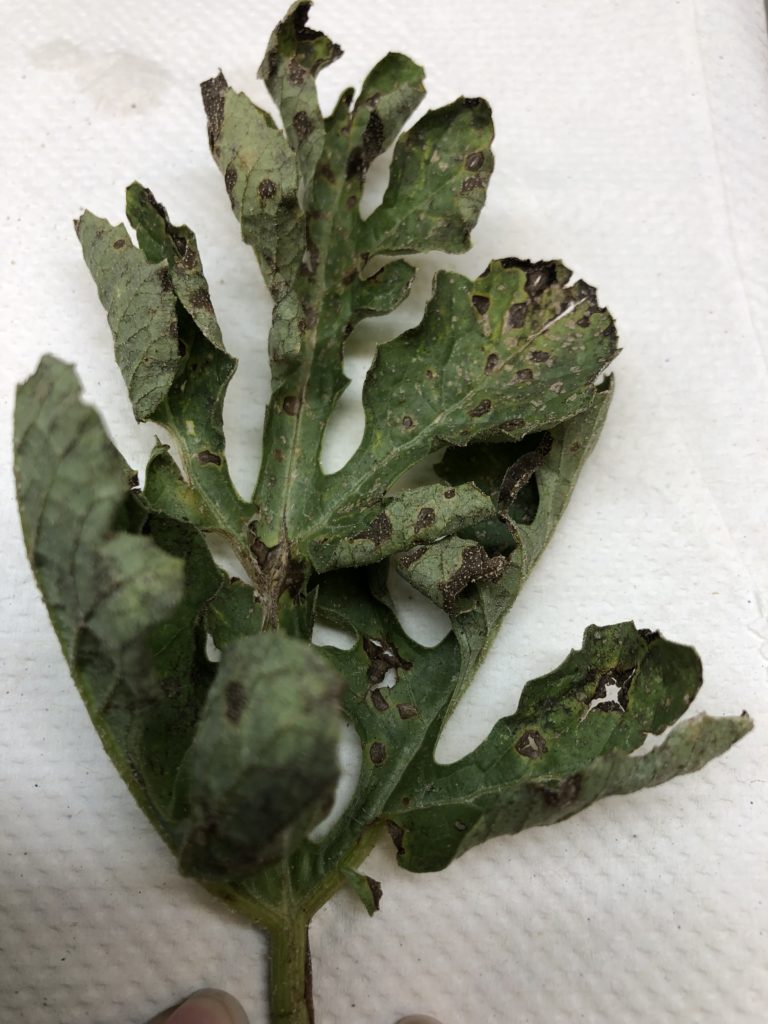By Navjot Kaur and Bhabesh Dutta
Watermelon anthracnose is caused by the fungal pathogen Colletotrichum orbiculare, which impacts all above-ground parts of the plant. C. orbiculare also causes anthracnose in other cucurbit crops such as cucumber, muskmelon, squash, gourd, pumpkin, cantaloupe and honeydew.
The disease is favored by conditions including high humidity, rainfall, overhead irrigation and warm temperatures in the range of 65 to 80 degrees. The pathogen can survive by overwintering in the debris of the previous infected crop. Disease spores can be introduced in production fields via multiple means such as infested seeds or transplants, infected plant debris and volunteer plants. Spread within and between fields is mediated by wind-driven rain or overhead irrigation.
SIGNS OF SYMPTOMS
Anthracnose symptoms can appear on leaves, stems and fruit.
Foliar symptoms are quite distinct and appear as blackish brown lesions, often leading to shot-hole appearance in leaves (Figure 1). Severe infections can cause vine defoliation and can result in losses in yield and quality.

On petioles and stems, symptoms appear as sunken, dark, spindle-shaped lesions (Figure 2), which usually penetrate deep and lead to stem girdling.

Photo by David Langston
Signs of the pathogen can be seen on mature fruits in the form of spore masses (Figure 3). Infection on fruit results in circular, water-soaked, sunken spots with fungal spores at the center. Secondary infection can occur in storage bins when infected fruit come in close contact with healthy fruit.

OUTBREAKS AND MANAGEMENT
Recently, severe anthracnose outbreaks in watermelon and cucumber have occurred in several cucurbit-growing counties in Florida, Georgia, South Carolina, Virginia, Delaware and New York. In the United States, the annual losses of watermelon and cucumber yield due to anthracnose are hard to estimate. However, a conservative estimate is several hundreds of thousands to millions of dollars.
Integrated disease management practices for anthracnose include host resistance, use of clean seed, crop rotation, deep plowing of crop residue after harvest and avoiding farm machinery use after rainfall events and/or overhead irrigation. Post-harvest management may include grading out infected fruit or fruit with any suspected symptoms.
For chemical management, cucurbit growers have traditionally relied on the quinone outside inhibitor (QoI) fungicides such as azoxystrobin and pyraclostrobin [Fungicide Resistance Action Committee (FRAC) group 11]. However, over the last three years, a noticeable reduction in disease suppression was observed for QoI fungicides in the eastern United States.
ONGOING RESEARCH EFFORTS
Based on our University of Georgia (UGA) preliminary investigation, we observed that Colletotrichum spp. isolates collected in Georgia were potentially resistant to azoxystrobin using in-vitro fungicide sensitivity assays. These results were consistent with field observations made by cucurbit growers in the northeastern and southeastern United States, which included little to no azoxystrobin efficacy.
An important consideration is whether the sudden loss in QoI efficacy is due to the introduction of a new Colletotrichum spp. or species complex in cropping systems that is inherently resistant to this chemistry. Preliminary investigations do not support this, but further research involving isolates from different regions and different cucurbit hosts needs to be assessed. The identity and distribution of these isolates along with their fungicide sensitivity profiles need to be investigated. Another critical aspect is the knowledge of level of resistance against this pathogen or pathogen complex in commercial cultivars of different cucurbits hosts, including watermelon, squash, cucumber, pumpkin, cantaloupe and others.
Our UGA research is currently evaluating the distribution of species complex across different watermelon/cucurbit growing fields in southern Georgia. This involves collection of isolates across different years and fields and utilizes published protocols to determine if C. orbiculare is still a dominant species causing anthracnose.
The research team is also interested in evaluating the current status of fungicide sensitivity profiles of isolates against a panel of fungicides that are commonly used by growers (Quadris and Cabrio, FRAC group 11) and also against a panel of fungicides that are labeled for use in cucurbit crops. UGA horticulturists Ted McAvoy and Tim Coolong are assessing if commercial watermelon and other cucurbit cultivars have some level of resistance against the current pathogen populations.
Navjot Kaur is a post-doctoral research associate, and Bhabesh Dutta is an associate professor and Extension vegetable disease specialist — both at the UGA in Tifton.










